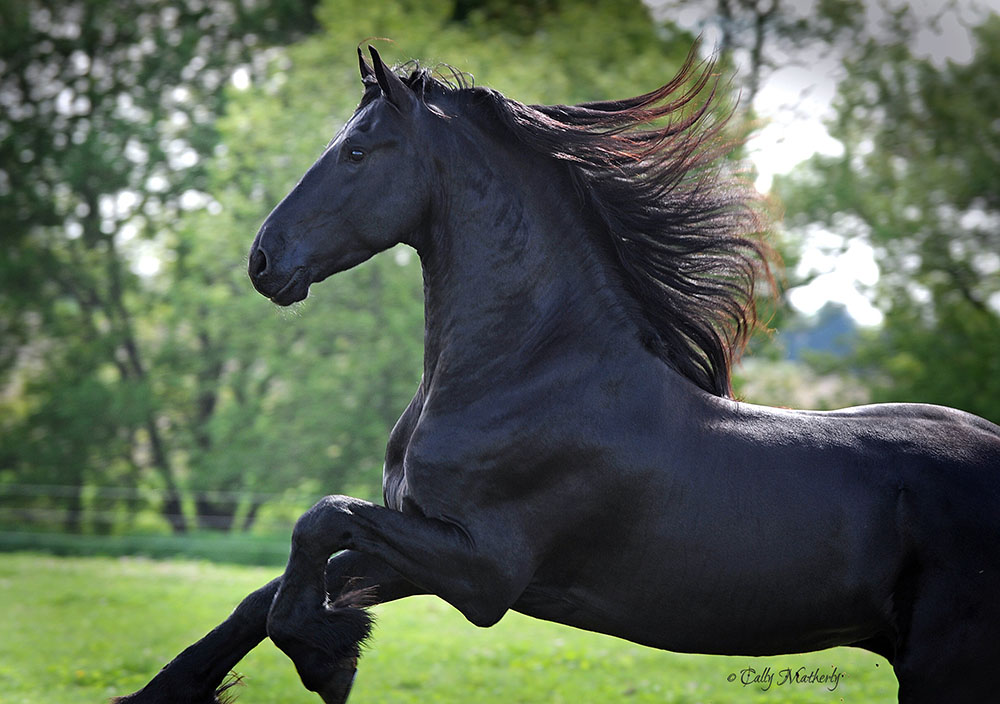
The Friesian horse is truly a unique breed, developed from a very old breed which was inherent to all of Western Europe. It's native to The Netherlands. Historically speaking, the Friesian horse has been influenced by eastern bloodlines and has often been threatened with extinction.
Thanks to the single-mindedness and dauntless dedication of true horse lovers, one can still appreciate the many facets of the Friesian horse today.
Always black, with thick flowing mane and tail, large in stature, with substantial bone, this horse is the proverbial “ black stallion. “ Many little girls grew up dreaming about such a horse!
Friesians are a very old breed of horse, having been developed in the north province of Friesland, in the Netherlands centuries ago. Used as draft animals, as well as cultivated to become the wealthy owner’s high stepping carriage “Sunday Horse”, the breed is very much a national treasure of the Netherlands.
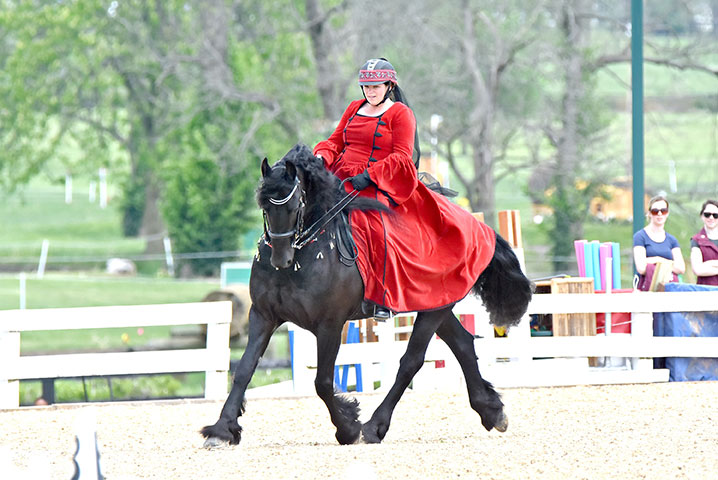
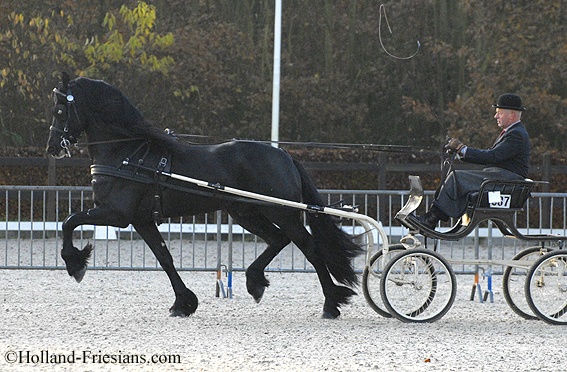
Friesian Breed Registration KFPS:
As the Friesian people developed this breed over 135 years ago, they saw the value of an association that would guide and oversee the future development. They first collected as many good representations of the breed, and selected stallions to be used as sires for the coming generations.
They then, over a period of time, had people who were familiar with the breed, judge the offspring as foals, in the summer and fall of the year they are born, and then again as young adult horses, around 3 and 4 years old. Horses are ranked on conformation, breed type, quality of legs and movement at the walk and trot. Their total score determines their placement in the national “Studbook” or breed registration.
Very exceptional mares and stallions are recognized with “Star” predicates, and are given the opportunity to advance further in the studbook. Mares can advance to the “Crown” predicate; and even further to “Model”, “Preferant” or “Prestatie” designations, dependent upon their ability in performance and the quality and ability of their offspring.
Stallions, since they have the ability to affect many more breeding’s than the mares, go through perhaps the most stringent process in the horse world for approval. If selected in their inspection at three years as exceptional, these stallions go on to a second look by the judges. Their pedigrees are evaluated for value to the breed, and the quality of all ancestors involved.
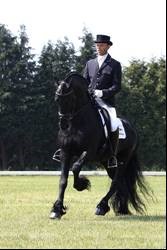
If these are found to be valuable enough to the breed as a whole, the horse submits x-rays of feet and legs, and an analysis of their semen, to determine if it is of good enough quality.
When the horse is approved on x-rays and semen quality, it is invited to a “70 day approval process”. The horses are sent to an approved facility, and undergo rigorous testing and training to see their ability in riding and driving. They are examined by a veterinarian upon arrival, and a panel of judges who specialize in stallions, to determine a baseline for training.
They are seen again at 35 days and evaluated; when horses who are not making enough progress can be excused, and again at the end of the 70 days, for a final evaluation and scoring.
If their scores are high enough, they are given a “number” after their name, and a provisional license to breed a limited (180) number of mares. The resulting offspring are again evaluated as foals, and three and four yr. olds to determine if the stallion’s offspring fulfill the promise of their sires. An assigned number of the 3 and 4 year old offspring are tested in a 30 day evaluation of their ability, conformation and whether or not they are a “positive addition to the breed.“ If enough of the approximately 20 offspring pass the evaluation, the Stallion is given unlimited breeding privileges.
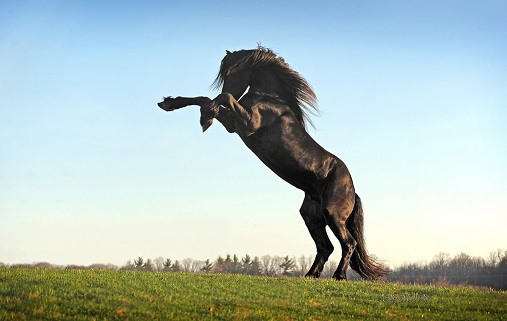
The Friesian Horse in America:
When the new world was discovered, Friesian horses made their way here too. Dutch settlers, probably the same settlers that bought Manhattan Island from the Indians and named it “New Amsterdam”, brought the breed to America.
It is believed that the Friesian may have contributed to the bloodlines of what would eventually become the Morgan horse, the Canadian horse and the Tennessee walker. In American, cross breeding soon resulted in the disappearance of the purebred Friesian for many years.
It wasn't until the 1970 when Thomas Hannon imported a number of these horses that the Friesian set hoof on the U.S. shore once again. Shortly thereafter, Friesian breeders on the West Coast imported several mares and a stallion. Ever since then, their popularity has grown. In the last 15 years, the number of Friesians in the US has gone from less than 1,000 to more than 15,000.
There was a huge influx of imported horses in the early 2000’s, but that has stabilized into a healthy sized breeding population now. With approximately 20 fully approved KFPS Breeding Stallions located in NA.
With their easy going temperaments, Friesians have captured the hearts of many horse lovers. Heavy-boned, jet black and high stepping, this breed makes a beautiful carriage horse as well as a dramatic saddle and exceptional dressage horse. With more interest all the time in Friesians for dressage, and breeding goals started changing to make a taller, lighter horse, to accommodate these sports’ needs.
With such a distinguished breed, guidelines for breeding are in order. The Friesian Horse Association of North America, FHANA, is the representative for the US and Canada working with the original Friesian horse association, Friese Paarden Stamboek, KFPS, in the Netherlands.
Established in 1879, the KFPS maintains the studbook for all European Friesians, and has over 10,000 members worldwide. FHANA celebrated its 25th anniversary in 2009, while the KFPS celebrated its 130th. FHANA is the only recognized affiliate in North American for the KFPS.
To oversee and control quality of the horses being bred, KFPS requires that only foals with a dam in the Main Studbook, (mare studbook or Foal Book) and a stallion with KFPS approved breeding privileges shall be registered in the main stud book. The number of approved breeding stallions in the US is small, approximately 20, although approved stallions in the NL are available to breeders through the importation of frozen semen. Over the past four decades. The Friesian horse has grown from a European legend to a common sight for many horse lovers here in the United States. No doubt the breeds’ dramatic looks and tractable temperament will continue to provide horse lovers with more reasons to cherish this majestic breed.
Their dramatic look makes them a natural in television, commercials and movies, and they are seen more often than ever. Friesians were included in movies and television shows including Zorro, Once upon a Time, Lady Hawke and Bedazzled to name but a few.
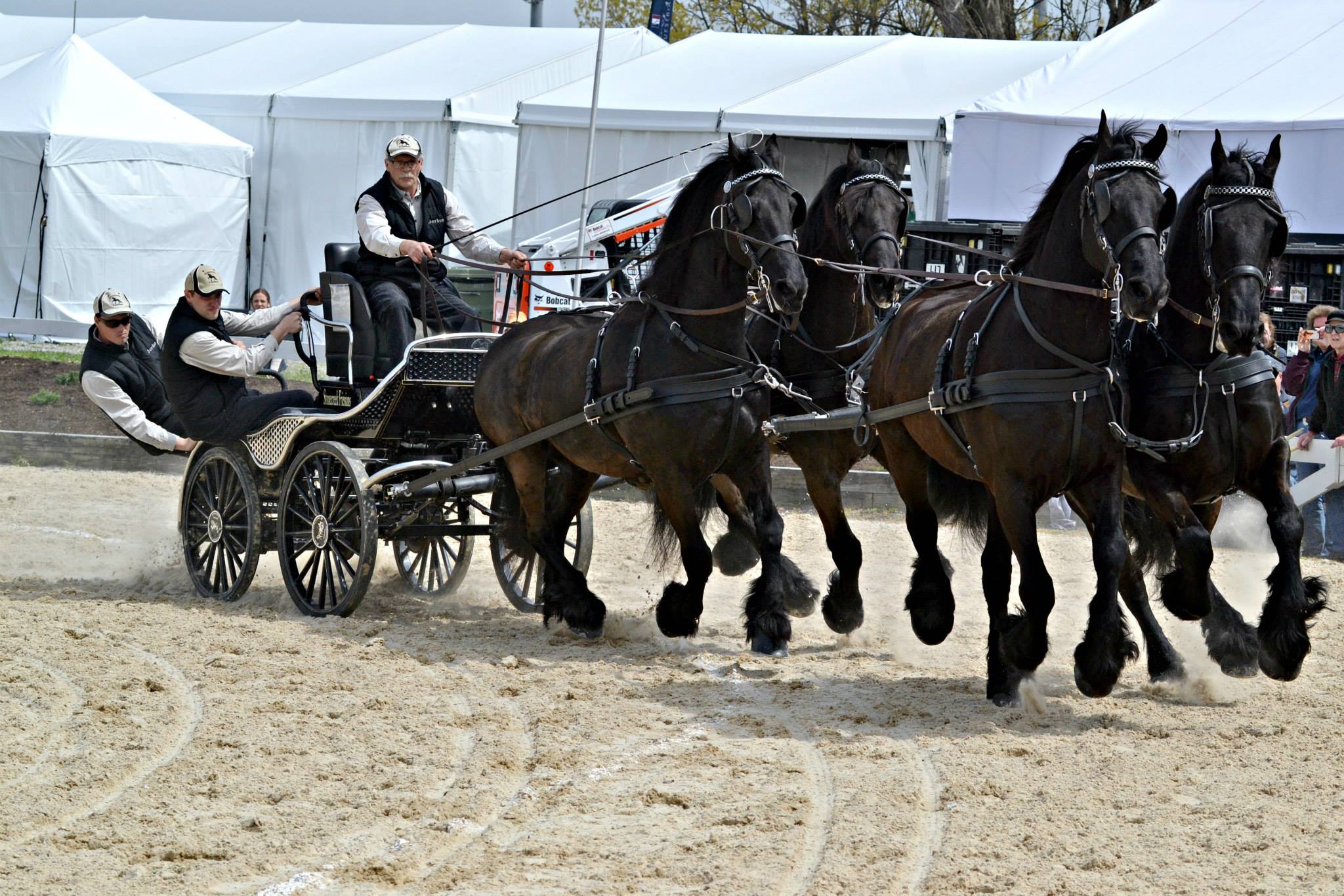
The Versatility of the Friesian Horse.
Friesian Horses were considered to be among the group of semi-draft horses used as mounts for fighting men in the times of the Crusades. As that type of use dwindled, they were adapted to farming and general use by the population.
Friesian families would keep their especially beautiful horses for the Sunday drive to church. At this time they also had trotting competitions in the Netherlands, with horses competing against each other for the fastest trot, without breaking into a canter.
Friesian horses are well suited to driving, either singly or in multiples. There is little more impressive than a four in hand of beautiful Friesians. They are used for CDX driving worldwide, as well as parade horses, with several groups of Friesians being represented in the Rose Bowl Parade for many years now.
The typical wonderful temperament of the Friesian horse makes it a very suitable pleasure riding mount as well. The Friesian horse has been bred for not only beauty, good conformation and the ability to move well, but also for its work ethic, and temperament for many generations now.
This breed typically loves people and rather than running away when you go to fetch it from the pasture, they come to their owners. Always curious and interested in what is going on, they display a good level of intelligence.
In the last 10 to 15 years the interest in Friesian for Dressage riding has grown exponentially in Europe and North America, with Friesians starting to compete at the highest levels. This is not to say that all Friesians are Pre St George candidates, but neither are all people suited to riding at that level. With training, many horses compete successfully at all levels.
With proper conditioning, Friesians are also making their way into the Endurance competition arena. Granted, we have not seen them in the severe long distance events like the Tevis Cup in California, but they can compete in shorter events, when properly conditioned.
For those people who enjoy the competition of a Horse Show, the Friesian with its flowing mane and tail and good looks is always a show stopper. Friesians have their own recognized affiliation with the USEF, through the International Friesian Show Horse Association. This association organizes regional events throughout the year and holds a yearly event to recognize the participants.
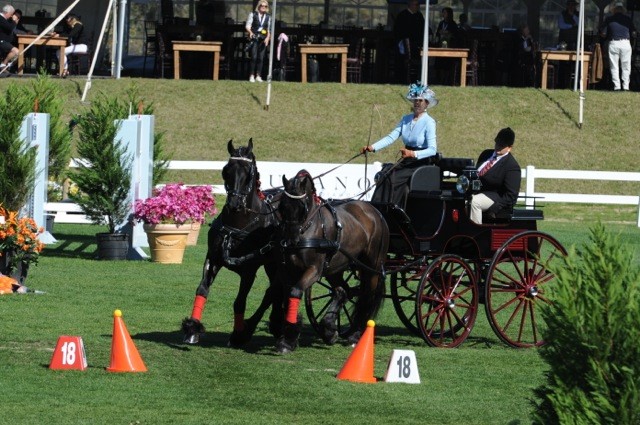
The Friesian Horse Association of North America
Started by a group of Friesian/American citizens, over 28 years ago, this “daughter” of the KFPS, is the largest association of Friesian owners outside of the Netherlands. The KFPS, the only recognized Friesian Studbook in the world, and the only studbook authorized by the EU in Europe, has been in business for over 133 years continuously.
KFPS loosely translates as “Royal Friesian Horse Studbook”, tracks all registered Friesian horses in the world, thru its own and its’ affiliates efforts. More information is gathered, analyzed and tracked about the health, breeding statistics, sports ability and overall performance of the Friesian horse than most other breeds in the world.
As a “closed studbook”, meaning that no other breeds are allowed to enter the gene pool, it is by necessity, a rather inbred horse breed, particularly if you track it back as you can to the original stallion used and mares he was bred to. This makes the close monitoring of the breeding stock all the more necessary.
The KFPS is well aware of specific genetic flaws that may be present in the Friesian breed, just as there are specific genetic flaws in most breeds of horses, dogs, and just about everything that lives and breathes.
FHANA manages the official paper work from the KFPS for their members in the North American continent. FHANA also organizes the yearly inspection circuits for the Inspectors and Judges from the Netherlands to come to the US and Canada, to do yearly inspections of our horses here, to make sure that our breeding goals is aligned with theirs.
At these yearly inspections, our foals and 3 and 4 year olds are evaluated, and ranked within the overall breed population. Foals are given a First, Second or Third premium, or none at all. Older mares and geldings are rated similarly, with the top 5% being awarded a First or Second Premium “Star”.
They can go from there, if selected, to the Crown rating, then on to Model, based on their conformation, performance and ability to pass an IBOP test. That is a test that evaluates sport/riding/driving potential. A model mare must have also had a live foal.
Other premiums are available for the ability to pass their good genetics to offspring; a mare with four Star offspring is considered to be a Preferant Mare. Horses of either sex can earn, with a set number of high scores in either riding or driving, a “Sport” Predicate. Mares with enough offspring doing well in sports can earn a “Prestatie Mare” predicate.
As an organization, FHANA is always trying to add value for its members. By partnering with a variety of horse related businesses, they have secured discounts for members on a variety of things. They have introduced a Webinar series of topics that are timely and informative, and can be viewed after the actual Webinar takes place, if you can’t be there to attend.
They have compiled a list of clinicians to get out to the varying Chapters and present a wide variety of relevant topics. FHANA has a yearly Annual General Meeting, where the current finances and budget are presented to the members, and topics of interest are presented by a wide range of speakers.
FHANA's office in the Kentucky Horse Park is open Monday thru Friday, and they are always happy to have members visit.
Visit their website at www.fhana.com
You can find more informative articles in our section on Health & Education and Horse Breeds.
Are you interested in promoting your business or sharing content on EIE? Contact us at info@equineinfoexchange.com

































